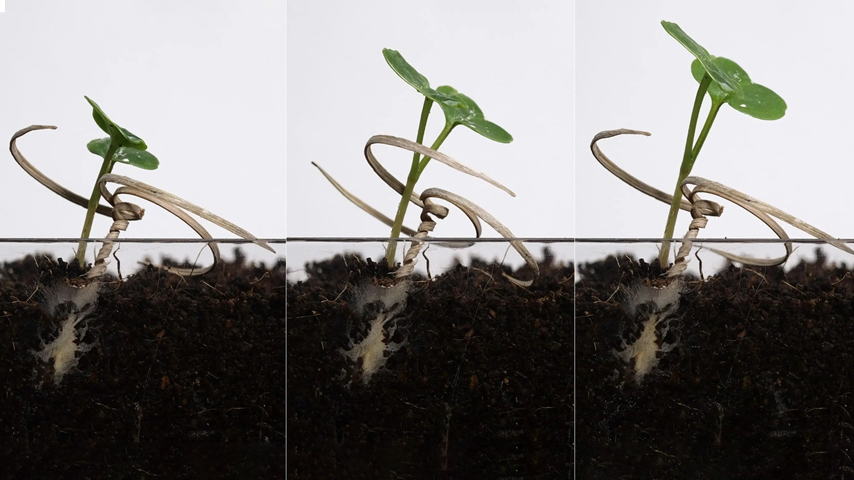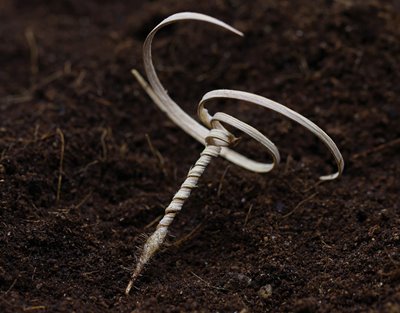Flower Inspires New Take on Self-Planting Seeds
Flower Inspires New Take on Self-Planting Seeds


A new bio-inspired self-drilling carrier can not only aerially deliver seeds to areas impacted by climate disasters, but also other vital nutrients to help support vulnerable ecosystems.
Gazing upon the Erodium flower, a small five-petaled Geranium-like bloom that blossoms in whites, pinks, and purples, it’s not necessarily clear why the bud is known colloquially as the “stork’s bill.” But one look at its unique seed carrier, with its tell-tale spiky, coiled bill, and it all starts to make sense. This unique design allows the Erodium seed to bury itself, as the long tail works to drill it down into the soil to take root–while its shaggy hairs work to prevent the seed from resurfacing–before it can be eaten by birds or baked into senescence by the blazing sun.
Now, a multidisciplinary group researchers have developed a new three-tailed wooden seed carrier inspired by the stork’s bill called the E-seed. Teng Zhang, a professor of mechanical and aerospace engineering at Syracuse University, said he and his colleagues mimicked Erodium’s self-drilling design to improve the effectiveness of aerial seeding, particularly in areas that may have been negatively affected by climate change.
“This is a process used to quickly cover large and physically inaccessible areas for agricultural and environmental purposes,” he said. “This innovative system is expected to improve the effectiveness of aerial seeding to relieve agricultural and environmental stressors.”
Similar Reading: Robotic Dandelion Seed Takes Flight
Mother Nature created a quite effective innate burying mechanism with the Erodium plant. As its signature tail is moistened by rain and dried out by the sun, it winds and unwinds to better drive the spiky bill–and, consequently, the plant’s seed–into the ground. Yet, Zhang and colleagues thought they could improve upon this sophisticated design to make it even more efficient and effective at self-burial.
Lining Yao, director of the Morphing Matter Lab at Carnegie Mellon University’s Human-Computer Interaction Institute, said the team used a variety of computer science models to come up with a design that would allow for maximum self-burying capabilities. That includes the addition of two more tails to increase the torque of the carrier, allowing it to better twist seeds or other cargo deep into the ground regardless of weather or ground conditions.
“People have studied the mechanics, physics, and materials science of seed burial for a long time,” she said. “We used these models to come up with an optimal design. Our seed carriers have a highly stiff structure and a hydromorphic bending or coiling actuator with an extremely large bending curvature of 1,854 m-1. These unique features allow the carriers to drill into the ground and protect the payloads, including biofertilizers and plant seeds, from direct exposure to harsh sunlight, wind, and granivorous birds, as well as undesirable air humidity and temperature.”
Become a Member: How to Join ASME
The team opted to use thin strips of wood veneer to create the body and three tails of the carrier, which act as actuators to help the carrier successfully drill the seed into the ground. The veneer also bends and twists in response to moisture, like the Erodium carrier does.
“Gaining insight into the mechanics of wood and seed drilling dynamics leads to improved design and optimization,” said Zhang. “To our knowledge, this is the first eco-friendly and cost-effective material that can fulfill all the mechanical and manufacturing constraints required to create this kind of carrier.”
The researchers tested the effectiveness of the carriers in a series of experiments. Drones dropped E-seeds into different areas and the research team counted how many germinated. They saw about an 80 percent success rate on flat lands.
“Over the past two years, we conducted five outdoor drilling experiences with 136 three-tailed seed carriers in both the U.S. and China,” said Yao. “We learned that the performance of our system varies a lot depending on environmental conditions, such as the precipitation rate and temperature, as well as the soil conditions.”
You Might Also Enjoy: 5 Agricultural Robots Bringing Food to the Table
Design customizations can be made to tailor the carriers to different physical restraints, Yao said. The group also created a larger version of the carrier to help deliver larger pine tree seeds, as well as a more effective burying version to carry a payload of soil-boosting nematodes. Yao said they will continue to look at different ways to customize the E-seed to support different applications.
And those applications are many. The group states that such a carrier can be used to help aerially seed agricultural fields, as well as enhance reforestation efforts. But there’s much more it can do, said Yao.
“By interviewing domain experts in agriculture and forestry, we learned there are many potential practical ways this invention could help create social impact in front of the climate disaster,” she said. “It can deliver seeds, of course. But the domain experts also suggested that these self-burying seed carriers can be used to deliver fungi and beneficial nematodes to different areas–both of which are essential to a healthy ecosystem in the forest or agricultural lands. We could also use the carrier to deliver soil or other environmental sensors to understand what’s happening in the natural environment, which is also much needed.”
Kayt Sukel is a technology writer in Houston.
Now, a multidisciplinary group researchers have developed a new three-tailed wooden seed carrier inspired by the stork’s bill called the E-seed. Teng Zhang, a professor of mechanical and aerospace engineering at Syracuse University, said he and his colleagues mimicked Erodium’s self-drilling design to improve the effectiveness of aerial seeding, particularly in areas that may have been negatively affected by climate change.
“This is a process used to quickly cover large and physically inaccessible areas for agricultural and environmental purposes,” he said. “This innovative system is expected to improve the effectiveness of aerial seeding to relieve agricultural and environmental stressors.”
Similar Reading: Robotic Dandelion Seed Takes Flight
Mother Nature created a quite effective innate burying mechanism with the Erodium plant. As its signature tail is moistened by rain and dried out by the sun, it winds and unwinds to better drive the spiky bill–and, consequently, the plant’s seed–into the ground. Yet, Zhang and colleagues thought they could improve upon this sophisticated design to make it even more efficient and effective at self-burial.
Lining Yao, director of the Morphing Matter Lab at Carnegie Mellon University’s Human-Computer Interaction Institute, said the team used a variety of computer science models to come up with a design that would allow for maximum self-burying capabilities. That includes the addition of two more tails to increase the torque of the carrier, allowing it to better twist seeds or other cargo deep into the ground regardless of weather or ground conditions.
“People have studied the mechanics, physics, and materials science of seed burial for a long time,” she said. “We used these models to come up with an optimal design. Our seed carriers have a highly stiff structure and a hydromorphic bending or coiling actuator with an extremely large bending curvature of 1,854 m-1. These unique features allow the carriers to drill into the ground and protect the payloads, including biofertilizers and plant seeds, from direct exposure to harsh sunlight, wind, and granivorous birds, as well as undesirable air humidity and temperature.”
Become a Member: How to Join ASME
The team opted to use thin strips of wood veneer to create the body and three tails of the carrier, which act as actuators to help the carrier successfully drill the seed into the ground. The veneer also bends and twists in response to moisture, like the Erodium carrier does.
“Gaining insight into the mechanics of wood and seed drilling dynamics leads to improved design and optimization,” said Zhang. “To our knowledge, this is the first eco-friendly and cost-effective material that can fulfill all the mechanical and manufacturing constraints required to create this kind of carrier.”
The researchers tested the effectiveness of the carriers in a series of experiments. Drones dropped E-seeds into different areas and the research team counted how many germinated. They saw about an 80 percent success rate on flat lands.
“Over the past two years, we conducted five outdoor drilling experiences with 136 three-tailed seed carriers in both the U.S. and China,” said Yao. “We learned that the performance of our system varies a lot depending on environmental conditions, such as the precipitation rate and temperature, as well as the soil conditions.”
You Might Also Enjoy: 5 Agricultural Robots Bringing Food to the Table
Design customizations can be made to tailor the carriers to different physical restraints, Yao said. The group also created a larger version of the carrier to help deliver larger pine tree seeds, as well as a more effective burying version to carry a payload of soil-boosting nematodes. Yao said they will continue to look at different ways to customize the E-seed to support different applications.
And those applications are many. The group states that such a carrier can be used to help aerially seed agricultural fields, as well as enhance reforestation efforts. But there’s much more it can do, said Yao.
“By interviewing domain experts in agriculture and forestry, we learned there are many potential practical ways this invention could help create social impact in front of the climate disaster,” she said. “It can deliver seeds, of course. But the domain experts also suggested that these self-burying seed carriers can be used to deliver fungi and beneficial nematodes to different areas–both of which are essential to a healthy ecosystem in the forest or agricultural lands. We could also use the carrier to deliver soil or other environmental sensors to understand what’s happening in the natural environment, which is also much needed.”
Kayt Sukel is a technology writer in Houston.






